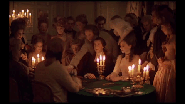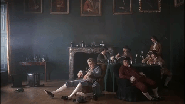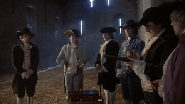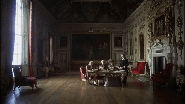-
About
- About Listly
- Community & Support
- Howto
- Chrome Extension
- Bookmarklet
- WordPress Plugin
- Listly Premium
- Privacy
- Terms
- DMCA Copyright
- © 2010-2025 Boomy Labs


 Frontrunner Magazine
Frontrunner Magazine
Listly by Frontrunner Magazine
For those just getting into the oeuvre of Stanley Kubrick, Barry Lyndon can seem like the redheaded stepchild in his body of work. It lacks the groundbreaking psychedelic effects of 2001: A Space Odyssey, the sleek brutalist ultra violence of A Clockwork Orange, and the dread-inducing Grand Guignol soul horror of The Shining. In fact, on paper, Barry Lyndon kinda sounds like the cinematic equivalent of homework: a three hour 18th century costume drama starring one of the most derided actors of the 70s that flopped at the box office? It’s no wonder that nascent cinephiles often end up putting off watching this film for as long as they can. It’s also a pity: not only is Barry Lyndon one of Kubrick’s best films — a witty, suspenseful, moving tale of a roguish Irish farm boy (Ryan O’Neal) who grifts and cons his way to the top of British high society before facing a precipitous fall from grace — it is arguably Kubrick’s most visually stunning film. There are individual frames of Barry Lyndon that could be blown up, framed, and displayed on the walls of any fine art museum in the world. To attain those sumptuous images, Kubrick had to figure out a way to shoot scenes that were only lit by candlelight, and how to mimic on film the look of an 18th century painting. In honor of the film’s recent Criterion reissue, here’s how he and cinematographer John Alcott accomplished just that:

From the start, Kubrick was dead set on avoiding the stuffy, artificial, studio-shot look of every other costume drama. He wanted Barry Lyndon to look as though it had actually been filmed in 18th century Europe. The first problem to solve was how to shoot by candlelight, without the use of electricity, which proved to be a very daunting challenge. Kubrick and his director of photography, John Alcott, tried out a number of combinations of lenses and film stock, before they found the answer: the Carl Zeiss Planar 50mm f/0.7, three super-fast 50mm lenses which were manufactured by Zeiss, for use by NASA in the Apollo moon landings. These were used for the close-ups and medium shots for scenes that were lit only by candlelight, and an added zoom lens that shrunk the ratio down to 36.5mm captured the wide shots.

The Zeiss lenses were originally made for still photography, so mounting them on Kubrick’s Mitchell BNC camera proved to be difficult, as the lens was so big that it fell mere millimeters away from the film plane. So Kubrick had the lenses and cameras modified by Cinema Productions Corp., and consulted with optics expert Richard Vetter of Todd-AO on how best to gain a wide angle of view. This was especially important, as the Zeiss lenses allowed for almost no depth of field, necessitating each scene to be mapped out by inches from the lens. Alcott, who won an Oscar for his work on the film, often shot these scenes with the lens wide open, giving Barry Lyndon the distinction of being shot at the lowest f-stop in film history. Most scenes were lit at an average of three candela, a remarkably low number. Furthermore, in order to give the finished product a unified look, in post-production, Kubrick had the entire film push-developed one stop down.

This has lead to the belief that Barry Lyndon was shot exclusively with natural light, which is not true. For the second half of the film, in which Barry has successfully become a member of the aristocracy, Kubrick shot in a number of historic sites all across England and Ireland. He wanted these scenes to look like 18th century paintings, especially the work of William Hogarth. Also, since these locations were preserved, and in many cases used as museums which were open to the public, Kubrick and Alcott could not risk having their equipment accidentally cause any property damage. The director was very taken with how 18th century paintings recreated natural light, but found that lighting the interiors head on often looked phony. So instead they went for the next logical option: the windows.

Alcott placed small lights called Mini Brutes outside the windows, and then diffused the light by taping tracing paper or plastic filters to either the windows or the lights themselves, depending on the effect they were going for. Kubrick was especially taken with how, when he pointed the camera towards the windows, the tracing paper caused a very natural-looking lens flare. It also allowed the legendarily meticulous filmmaker to maintain a controlled environment that would look the same throughout a long day of shooting (and like all of Kubrick’s films, Barry Lyndon took a long time to shoot: a whopping eight months of principal photography), as well as affording him control as to where the light fell in the room, and the ability to maintain a regular f-stop, which was not often the case on this particular film.

Interestingly, given his reputation of being a taskmaster and a control freak, Kubrick almost never planned out his shots ahead of time. Instead, he would often let the actors performances and the lighting of the set dictate how he would shoot any given scene. He also refused to use stand-ins when choreographing his shots, which meant that the actors were required to be on set and in full costume and makeup at all times, much to the alleged annoyance of O’Neal.

Often times, when he was stumped on how to shoot a scene, Kubrick would literally consult one of his many books of 18th century paintings, and copy the staging verbatim, which can be seen in a number of scenes in the finished film. How fitting this is for what Stanley Kubrick achieved with Barry Lyndon: the film, quite literally, is a work of art.
